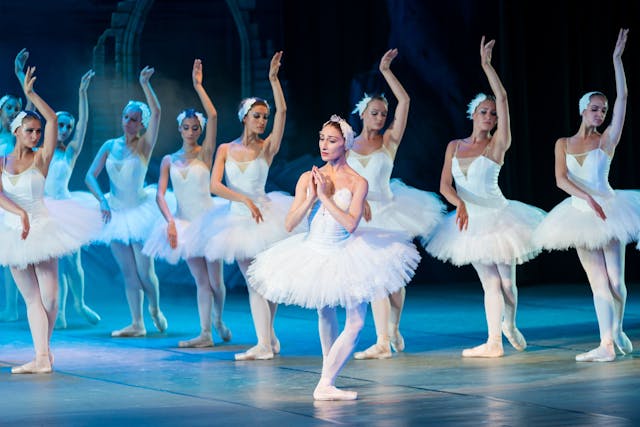In today’s post, we’re gliding into the graceful world of ballet, exploring the core terminology, essential positions and poses, and highlighting some of the most prestigious theatres where ballet comes to life. Whether you’re new to ballet or a seasoned admirer, let’s take a journey through the beauty of this classic art form.
Ballet Terminology: Core Terms You Should Know
Ballet has its own language, primarily rooted in French, that guides dancers through their movements with precision and elegance. Here are some of the key terms to familiarize yourself with:
- Barre: A horizontal handrail dancers use for support during warm-up exercises. It’s a critical part of ballet training, helping dancers refine balance, strength, and posture.
- Plié: Literally meaning “bent” in French, this refers to the bending of the knees while keeping the heels on the ground. It’s one of the foundational movements in ballet.
- Pirouette: A turn performed on one leg, often done in a series of spins. Dancers need exceptional balance and core strength to execute this move gracefully.
- Relevé: Rising to the balls of the feet or tips of the toes (en pointe), it emphasizes poise and control.
- Jeté: A leap from one foot to the other, where the dancer appears to be gliding through the air. It’s a dramatic and energetic jump often seen in ballet performances.
The Five Basic Ballet Positions
Ballet begins with mastering the five fundamental positions of the feet, each forming the basis for more complex movements. These positions align the body for balance and technique:
- First Position: Heels together, toes turned outward, forming a straight line with the feet.
- Second Position: Similar to first position, but with the feet spaced apart, about shoulder-width.
- Third Position: One foot in front of the other, with the heel of the front foot touching the arch of the back foot.
- Fourth Position: Like third position, but with the feet spaced apart, creating more dynamic balance for turns and jumps.
- Fifth Position: Feet turned outward and tightly crossed, with the heel of one foot touching the toes of the other. This is one of the most graceful and refined stances in ballet.

Poses in Ballet: Creating Pictures with Movement
In addition to the positions, ballet uses distinct poses that help tell the story of a performance. Here are a few notable ones:
- Arabesque: One of the most iconic ballet poses. In arabesque, the dancer stands on one leg with the other leg extended directly behind them, usually with the arms extended forward.
- Attitude: A variation of the arabesque, where the lifted leg is bent at the knee. It can be performed to the front, side, or back.
- Épaulement: Refers to the positioning of the shoulders and upper body in relation to the movement of the legs. It’s subtle but essential in conveying emotion and character in ballet.
- Tendu: A simple yet elegant movement where the working leg is stretched out to a point, either to the front, side, or back, without leaving the floor.
- Sous-sus: A tight position where the dancer rises onto pointe or demi-pointe, with the feet tightly crossed, creating a streamlined look.
The 5 Most Famous Ballet Theatres in the World
No ballet experience is complete without the grandeur of a world-renowned theatre. Each of these venues has a rich history of showcasing legendary ballet performances and continues to be home to the most celebrated companies and dancers globally.
- The Bolshoi Theatre (Moscow, Russia)
The Bolshoi Theatre is perhaps the most famous ballet theatre in the world. Home to the Bolshoi Ballet, this historic venue has been a beacon of Russian ballet for centuries. Its productions are known for their grandeur, strength, and technical brilliance. Attending a performance at the Bolshoi is like witnessing history unfold before your eyes. - The Royal Ballet and Opera (London, UK)
Nestled in the heart of Covent Garden, the Royal Ballet and Opera is the home of The Royal Ballet. With a legacy stretching back to 1732, this iconic theatre blends tradition and modernity. It offers a platform for both classical ballets like Swan Lake and groundbreaking contemporary works. - Opéra Garnier (Paris, France)
Paris is the birthplace of ballet, and the Opéra Garnier remains a cornerstone of the art form. Designed by Charles Garnier in the 19th century, its opulent interiors are as breathtaking as the performances. The Paris Opera Ballet is known for its elegance and precision, often considered the epitome of French ballet tradition. - Teatro alla Scala (Milan, Italy)
La Scala is one of Italy’s most famous opera houses, and its ballet company, Balletto del Teatro alla Scala, is world-renowned. The theatre’s stunning architecture and acoustics make it a prime destination for ballet lovers. With a rich history of hosting some of the most famous dancers and choreographers, La Scala’s stage is legendary. - Lincoln Center (New York City, USA)
Home to the New York City Ballet, Lincoln Center is the hub of American ballet. Founded by the legendary choreographer George Balanchine, NYCB is famous for its innovative approach and precision. Performances at the David H. Koch Theater within Lincoln Center are a must-see for any ballet enthusiast.

Final Bow
Ballet is an art form that requires years of training, passion, and dedication. Whether you’re trying to understand the basic terms and positions or dream of watching a performance at one of the world’s most prestigious theatres, ballet invites you into a world of grace, power, and beauty.
Next time you step into a theatre or hear the name of a famous ballet, you’ll have the knowledge to truly appreciate the artistry on stage. Here at GertieBlu, we’ll continue exploring the captivating world of dance, art, and culture—stay tuned for more insights!
Until next time.









